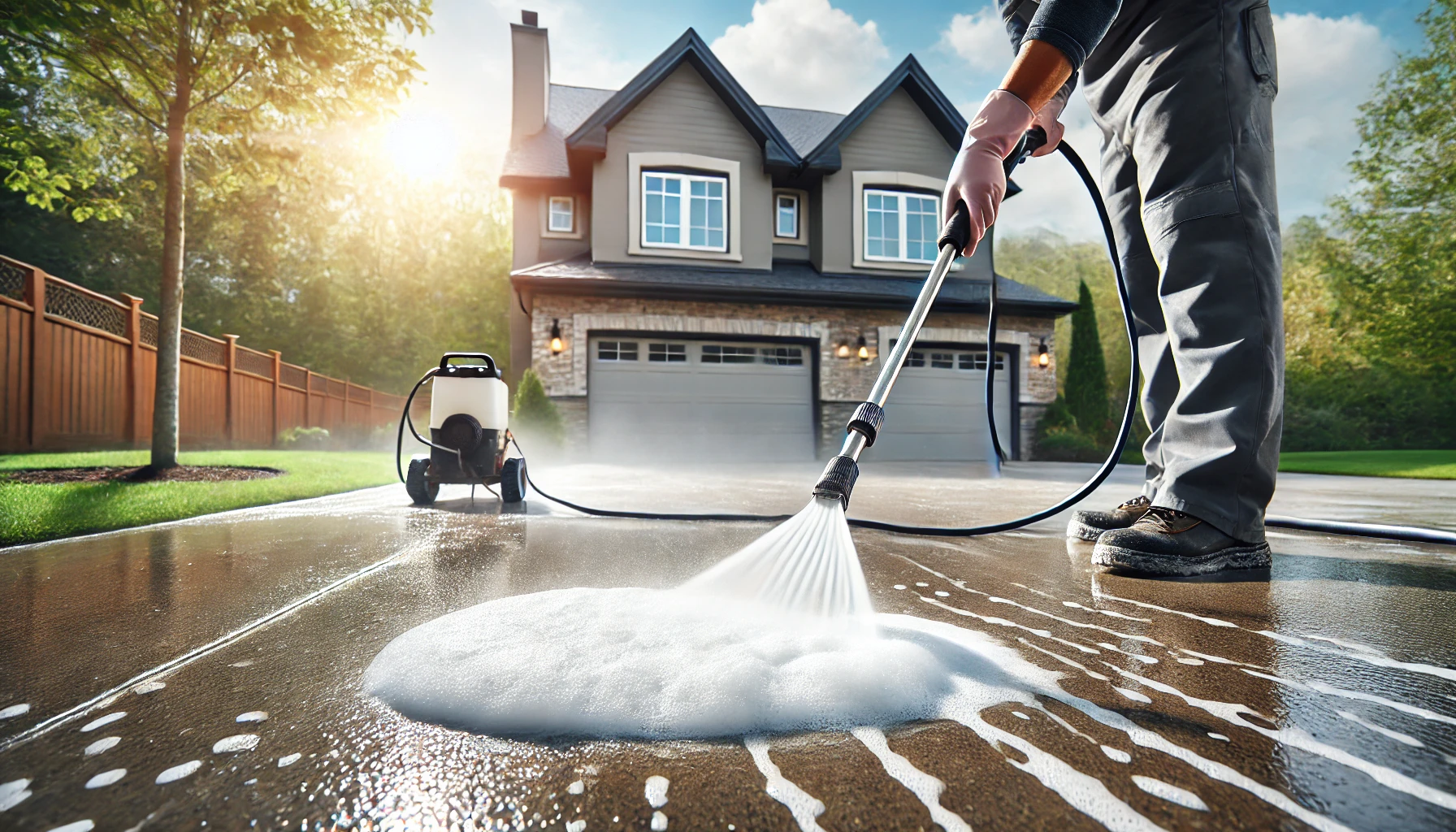Concrete Cleaning and Sealing: A Comprehensive Soft Wash Guide

Concrete surfaces, whether driveways, sidewalks, or patios, endure substantial wear and tear over time. Foot traffic, vehicle use, weather changes, and the buildup of dirt and stains can all reduce both the aesthetic and structural integrity of your concrete. Many homeowners turn to high-powered pressure washing to address these concerns, but improper use of pressure washers can cause damage and erode the concrete’s surface. A safer, equally effective alternative is softwashing, which relies on gentle water pressure and specialized cleaning solutions to restore concrete without risking undue wear.
In this comprehensive guide, we will explore:
- What to Spray on Concrete Before Pressure Washing (and why you might want to use a softwash alternative instead).
- Whether Pressure Washing Damages Concrete and how softwashing compares.
- How to Seal Concrete After Pressure Washing for enhanced longevity and curb appeal.
By the end, you’ll have all the steps you need to clean, protect, and maintain your concrete surfaces using softwash methods—plus, we’ll explain how and when pressure washing might still have its place.
Why Concrete Surfaces Need Proper Cleaning
Concrete is durable, yet it’s still a porous material prone to staining from oil spills, mold, mildew, algae, and general dirt accumulation. Over time, these contaminants can:
- Weaken the Surface: Chemicals and microorganisms can penetrate the pores of the concrete, gradually weakening it.
- Reduce Lifespan: Left unattended, trapped moisture and pollutants could shorten the concrete’s usable life.
- Affect Appearance: Stains and discoloration can make an otherwise well-maintained property look unkempt.
A strategic, thorough cleaning not only enhances the appearance of your concrete but also helps prevent damage and extends its lifespan.
Does Pressure Washing Damage Concrete?
Traditional pressure washing involves pumping out water at high pressure—often between 2,000 and 4,000 psi—to blast away dirt, mildew, and other contaminants. While this might sound efficient, the method presents some concerns:
- Surface Erosion: Excessive pressure can erode the surface layer of concrete, exposing aggregates and weakening the slab over time.
- Structural Cracks: For older or previously damaged concrete, high water pressure can exacerbate cracks or create new ones.
- Inconsistent Cleaning: Novices may leave streaks or cause uneven etching in the concrete by moving the pressure wand too quickly or holding it in one spot too long.
While pressure washing can be done safely by experienced professionals or careful DIYers—especially with lower psi settings and proper technique—it still poses risks. If you do opt for traditional pressure washing, be mindful of using the correct nozzle, maintaining consistent distance from the surface, and not exceeding recommended psi for concrete.
The Softwash Alternative
Softwashing provides a safer, often more thorough solution for cleaning concrete. Rather than relying on high water pressure, softwashing involves:
- Low-Pressure Delivery: Typically around 500 psi or less, which is gentle enough to avoid surface damage while still delivering cleaning agents effectively.
- Specialized Cleaning Solutions: These often include surfactants and mild, biodegradable detergents that break down dirt, algae, and mold at the root, eliminating growth rather than just blasting away the top layer.
By targeting contaminants chemically rather than relying on brute force, softwashing reduces the risk of erosion and can extend the clean appearance of your concrete for a longer period. Additionally, because the softwash solution seeps into the tiny pores of concrete, it disrupts the environment where mold, mildew, and algae thrive.
What to Spray on Concrete Before Pressure Washing (or Soft Washing)
Proper prep work is the key to an effective, long-lasting clean. If you plan to use a pressure washer, the same pre-treatment steps apply. For a softwash, these steps are even more critical to ensure a deep, even clean.
- Degreaser or Mild Detergent
- If your concrete has heavy oil or grease stains, applying a specialized degreaser will help break down these stubborn spots before you move on to the main cleaning.
- For milder stains, a light detergent or all-purpose cleaner is generally sufficient.
- Biocide or Algaecide
- When the concrete shows green or black discoloration from mold, moss, or algae, a biocidal pre-treatment can help eliminate the spores.
- Many commercial softwash solutions contain these ingredients, so read the label to avoid duplication.
- Soaking Agents
- Before applying any cleaning solution, lightly dampen the concrete. This helps the solution spread more evenly without evaporating too quickly, especially in warm weather.
How to Apply These Pre-Treatments
- Sprayer Attachment: Use a garden sprayer or low-pressure nozzle to apply the pre-treatment evenly.
- Dwell Time: Allow the solution to sit for 10–15 minutes (or as directed by product instructions). This dwell time lets the chemical agents penetrate the surface.
- Agitation (Optional): For heavily soiled areas, use a deck brush or broom to scrub the solution into the surface.
Step-by-Step Softwash Process
While the steps below focus on softwashing, you can adapt them if you’re using a pressure washer—just remember to adjust the psi to safer levels (2,000 psi or less) and use a fan-tip nozzle for a gentler approach.
Step 1: Inspection and Safety Check
- Inspect Concrete: Look for cracks, chipped areas, or deep stains that might need special attention.
- Gather Supplies: Ensure you have protective gear (gloves, goggles), cleaning solutions, a softwash system or low-pressure sprayer, and plenty of water for rinsing.
Step 2: Pre-Treat the Surface
- Apply Degreaser/Detergent: Spot-treat oil stains and areas with heavy grime.
- Use a Biocidal Agent: If mold or algae are present, apply an appropriate solution to kill these organisms at the root.
- Allow Dwell Time: Let it sit for 10–15 minutes or as recommended.
Step 3: Softwash Application
- Mix the Cleaning Solution: Follow the manufacturer’s guidelines for diluting the cleaning agent.
- Low-Pressure Spray: Using a softwash system or a spray nozzle with wide coverage, apply the solution evenly across the concrete.
- Brush Stubborn Spots: Gently scrub areas with embedded dirt or stains using a deck brush or bristle broom.
Step 4: Rinse Thoroughly
- Use Low Pressure: Rinse off the cleaning solution with a low-pressure hose or the same softwash equipment set to rinse mode.
- Avoid Standing Water: Try to push the dirty runoff toward a safe drainage area, keeping it away from plants or landscaped areas if the cleaning solution is not plant-friendly.
Step 5: Inspect the Result
- Spot Clean If Needed: If any stains remain, you may apply a second round of softwash solution.
- Allow to Dry: Let the concrete dry thoroughly before moving on to sealing.
How to Seal Concrete After Pressure Washing or Softwashing
Once your concrete is clean and free from stains, sealing it is the next critical step for protection and longevity.
- Choose the Right Sealer
- Penetrating Sealer: Ideal for exterior concrete, as it absorbs into the material, reinforcing it from within and providing long-lasting protection.
- Acrylic Sealer: Creates a protective film on the surface. Acrylic sealers can add a glossy or matte finish but may need reapplication every few years.
- Polyurethane/Polyurea: Highly durable and chemical-resistant, often used in garages or high-traffic areas.
- Prep the Surface
- Clean and Dry: Make sure the concrete is fully dry (24–48 hours of drying time is often recommended) and free of debris or residues.
- Test a Small Area: Apply a small amount of sealer in an inconspicuous location to ensure compatibility and appearance.
- Apply the Sealer
- Follow Manufacturer’s Instructions: Each product may have specific guidelines regarding application thickness, number of coats, and drying time.
- Use the Right Tools: Depending on the sealer, you might use a roller, sprayer, or brush.
- Work in Sections: This helps maintain a wet edge, preventing overlap marks.
- Curing Period
- Allow Time to Set: Avoid heavy foot or vehicle traffic until the sealer is fully cured. This can range from a few hours to several days, depending on the product.
- Multiple Coats (If Needed): Some sealers perform best with two or more thin coats rather than one thick coat.
- Long-Term Maintenance
- Clean Spills Quickly: Even the best sealers are not invulnerable to prolonged chemical or oil spills.
- Periodic Reapplication: Depending on the product and usage, you may need to reseal every 2–5 years.
Softwash vs. Pressure Washing: Key Takeaways
Safety for Concrete
- Softwash: Low-pressure approach reduces the risk of surface damage.
- Pressure Washing: Effective but risks erosion or cracks if misapplied.
Effectiveness
- Softwash: Cleans deeply by killing mold and algae at the source.
- Pressure Washing: Cleans quickly but might leave behind spores or roots of growth.
Maintenance
- Softwash: Slower regrowth of stains, so you can go longer between cleanings.
- Pressure Washing: May look clean initially but can require more frequent re-treatment.
Troubleshooting Common Concrete Cleaning Issues
- Persistent Oil Stains
- Solution: Use a stronger degreaser or cat litter to absorb excess oil before cleaning.
- Efflorescence (White Powder)
- Solution: This chalky residue is often caused by salts migrating to the surface. Use an efflorescence cleaner or mild acid solution, following all safety precautions.
- Uneven or Blotchy Appearance
- Solution: Reapply cleaning solution and rinse thoroughly. Uneven application or insufficient rinsing often causes blotches.
- Mold or Algae Return Quickly
- Solution: Ensure that you used a biocidal agent. Increase sunlight exposure by trimming landscaping that shades the concrete, and fix drainage issues.
Professional Services vs. DIY
If you’re comfortable using softwash equipment or a pressure washer with proper technique, cleaning and sealing your concrete can be a straightforward DIY project. However, professionals bring several advantages:
- Expertise: They understand the best psi levels, cleaning agents, and sealing products for your specific needs.
- Efficiency: A trained crew can complete the job quickly, especially for larger areas.
- Safety: Skilled pros reduce the risk of damage to the concrete or surrounding structures (like garage doors, siding, or landscaping).
Final Thoughts on Pressure Washing Concrete
Cleaning and sealing your concrete surfaces not only revitalizes your property’s appearance but also significantly prolongs the material’s functional life. While pressure washing can be safe and effective with the right approach, softwashing is often the preferred method for its gentle yet thorough results. By applying the correct pre-treatment products, using low-pressure equipment, and sealing the concrete afterward, you maintain a clean, robust surface for years to come.
If you’d rather let the best softwashing company in the Augusta area take care of the job for you, contact Sparkle Outdoor Services for a quote. We follow industry best practices to ensure that your concrete remains strong, stain-free, and visually appealing. Ultimately, our goal is to choose a method and products that protect your investment rather than compromise it—and softwashing is one of the safest bets.

Leave a Reply